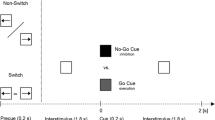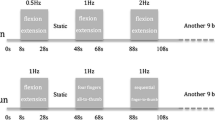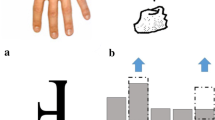Abstract
The slowness of movement, termed bradykinesia, is one of the main symptoms of Parkinson's disease (PD). This symptom may be due to the inability of PD patients to maximise the speed of internally driven movements. The mesial premotor areas and in particular the pre–supplementary motor area (pre–SMA) seem to play a crucial role in the temporal initiation of movements in humans and animals. However, this activation seems to be debatable in imaging studies of PD patients. We performed a motor paradigm with temporally self–initiated movements in nine de novo PD patients before and after initiation of dopaminergic medication. The main finding was an increased activation of the pre–SMA in de novo PD patients compared with healthy age–matched control subjects. This result indicates the contribution of the pre–SMA in the temporal initiation of self–generated movements and in the disease pathology of PD. Increased bilateral activation of the superior cerebellum, mainly on the ipsilateral side, and a decreased activation of the ipsilateral inferior cerebellum in PD patients were also present. These findings provide new insights into the activation pattern of the cerebellum in PD patients.
Similar content being viewed by others
References
Alexander GE, Crutcher MD, DeLong MR (1990) Basal ganglia–thalamocortical circuits: parallel substrates for motor, oculomotor, "prefrontal" and "limbic" functions. Prog Brain Res 85:119–146
Boecker H, Dagher A, Ceballos–Baumann AO, Passingham RE, Samuel M, Friston KJ, Poline J, Dettmers C, Conrad B, Brooks DJ (1998) Role of the human rostral supplementary motor area and the basal ganglia in motor sequence control: investigations with H2 15O PET. J Neurophysiol 79:1070–1080
Buhmann C, Glauche V, Sturenburg HJ, Oechsner M, Weiller C, Buchel C (2003) Pharmacologically modulated fMRI–cortical responsiveness to levodopa in drug–naive hemiparkinsonian patients. Brain 126:451–461
Carbon M, Ghilardi MF, Feigin A, Fukuda M, Silvestri G, Mentis MJ, Ghez C, Moeller JR, Eidelberg D (2003) Learning networks in health and Parkinson's disease: reproducibility and treatment effects. Hum Brain Mapp 19:197–211
Catalan MJ, Ishii K, Honda M, Samii A, Hallett M (1999) A PET study of sequential finger movements of varying length in patients with Parkinson's disease. Brain 122:483–495
Ceballos–Baumann AO, Boecker H, Bartenstein P, von Falkenhayn I, Riescher H, Conrad B, Moringlane JR, Alesch F (1999) A positron emission tomographic study of subthalamic nucleus stimulation in Parkinson disease: enhanced movement–related activity of motor–association cortex and decreased motor cortex resting activity. Arch Neurol 56:997–1003
Chen YC, Thaler D, Nixon PD, Stern CE, Passingham RE (1995) The functions of the medial premotor cortex. II. The timing and selection of learned movements. Exp Brain Res 102:461–473
Cunnington R, Windischberger C, Deecke L, Moser E (2002) The preparation and execution of self–initiated and externally–triggered movement: a study of event–related fMRI. Neuroimage 15:373–385
Dai TH, Liu JZ, Sahgal V, Brown RW, Yue GH (2001) Relationship between muscle output and functional MRImeasured brain activation. Exp Brain Res 140:290–300
Deiber MP, Honda M, Ibanez V, Sadato N, Hallett M (1999) Mesial motor areas in self–initiated versus externally triggered movements examined with fMRI: effect of movement type and rate. J Neurophysiol 81:3065–3077
Dietz MA, Goetz CG, Stebbins GT (1990) Evaluation of a modified inverted walking stick as a treatment for parkinsonian freezing episodes. Mov Disord 5:243–247
Fahn S, Elton R, Commitee atmotUPs– DRSD (1987) Unified Parkinson's Disease Rating Scale. In: Fahn S, Marsden CD, Calne D (eds) Recent developments in Parkinson's disease. MacMillan, New York, pp 153–163
Forster O (1936) Motorische Felder und Bahnen. In: Bumke O, Forster O (eds) Handbuch der Neurologie IV. Springer, Berlin, pp 298–299
Freeman JS, Cody FW, Schady W (1993) The influence of external timing cues upon the rhythm of voluntary movements in Parkinson's disease. J Neurol Neurosurg Psychiatry 56:1078–1084
Friston KJ, Frith CD, Frackowiak RS, Turner R (1995) Characterizing dynamic brain responses with fMRI: a multivariate approach. Neuroimage 2:166–172
Friston KJ, Holmes AP, Poline JB, Grasby PJ, Williams SC, Frackowiak RS, Turner R (1995) Analysis of fMRI time–series revisited. Neuroimage 2:45–53
Friston KJ, Holmes AP, Price CJ, Buchel C, Worsley KJ (1999) Multisubject fMRI studies and conjunction analyses. Neuroimage 10:385–396
Georgiou N, Iansek R, Bradshaw JL, Phillips JG, Mattingley JB, Bradshaw JA (1993) An evaluation of the role of internal cues in the pathogenesis of parkinsonian hypokinesia. Brain 116(Pt 6):1575–1587
Haslinger B, Erhard P, Kampfe N, Boecker H, Rummeny E, Schwaiger M, Conrad B, Ceballos–Baumann AO (2001) Event–related functional magnetic resonance imaging in Parkinson's disease before and after levodopa. Brain 124:558–570
Hoehn MM, Yahr MD (1967) Parkinsonism: onset, progression and mortality. Neurology 17:427–442
Jahanshahi M, Jenkins IH, Brown RG, Marsden CD, Passingham RE, Brooks DJ (1995) Self–initiated versus externally triggered movements. I. An investigation using measurement of regional cerebral blood flow with PET and movement–related potentials in normal and Parkinson's disease subjects. Brain 118:913–933
Jenkins IH, Fernandez W, Playford ED, Lees AJ, Frackowiak RS, Passingham RE, Brooks DJ (1992) Impaired activation of the supplementary motor area in Parkinson's disease is reversed when akinesia is treated with apomorphine. Ann Neurol 32:749–757
Jenkins IH, Jahanshahi M, Jueptner M, Passingham RE, Brooks DJ (2000) Selfinitiated versus externally triggered movements. II. The effect of movement predictability on regional cerebral blood flow. Brain 123:1216–1228
Lotze M, Erb M, Flor H, Huelsmann E, Godde B, Grodd W (2000) fMRI evaluation of somatotopic representation in human primary motor cortex. Neuroimage 11:473–481
Majsak MJ, Kaminski T, Gentile AM, Flanagan JR (1998) The reaching movements of patients with Parkinson's disease under self–determined maximal speed and visually cued conditions. Brain 121(Pt 4):755–766
Nakamura T, Ghilardi MF, Mentis M, Dhawan V, Fukuda M, Hacking A, Moeller JR, Ghez C, Eidelberg D (2001) Functional networks in motor sequence learning: abnormal topographies in Parkinson's disease. Hum Brain Mapp 12:42–60
Playford ED, Jenkins IH, Passingham RE, Nutt J, Frackowiak RS, Brooks DJ (1992) Impaired mesial frontal and putamen activation in Parkinson's disease: a positron emission tomography study. Ann Neurol 32:151–161
Rascol O, Sabatini U, Chollet F, Fabre N, Senard JM, Montastruc JL, Celsis P, Marc–Vergnes JP, Rascol A (1994) Normal activation of the supplementary motor area in patients with Parkinson's disease undergoing long–term treatment with levodopa. J Neurol Neurosurg Psychiatry 57:567–571
Rascol O, Sabatini U, Fabre N, Brefel C, Loubinoux I, Celsis P, Senard JM, Montastruc JL, Chollet F (1997) The ipsilateral cerebellar hemisphere is overactive during hand movements in akinetic parkinsonian patients. Brain 120:103–110
Rotte M, Kanowski M, Heinze HJ (2002) Functional magnetic resonance imaging for the evaluation of the motor system: primary and secondary brain areas in different motor tasks. Stereotact Funct Neurosurg 78:3–16
Sabatini U, Boulanouar K, Fabre N, Martin F, Carel C, Colonnese C, Bozzao L, Berry I, Montastruc JL, Chollet F, Rascol O (2000) Cortical motor reorganization in akinetic patients with Parkinson's disease: a functional MRI study. Brain 123:394–403
Sadato N, Ibanez V, Campbell G, Deiber MP, Le Bihan D, Hallett M (1997) Frequency–dependent changes of regional cerebral blood flow during finger movements: functional MRI compared to PET. J Cereb Blood Flow Metab 17:670–679
Samuel M, Ceballos–Baumann AO, Blin J, Uema T, Boecker H, Passingham RE, Brooks DJ (1997) Evidence for lateral premotor and parietal overactivity in Parkinson's disease during sequential and bimanual movements. A PET study. Brain 120:963–976
Shibasaki H, Sadato N, Lyshkow H, Yonekura Y, Honda M, Nagamine T, Suwazono S, Magata Y, Ikeda A, Miyazaki M, et al. (1993) Both primary motor cortex and supplementary motor area play an important role in complex finger movement. Brain 116(Pt 6):1387–1398
Siegert RJ, Harper DN, Cameron FB, Abernethy D (2002) Self–initiated versus externally cued reaction times in Parkinson's disease. J Clin Exp Neuropsychol 24:146–153
Stephan KM, Fink GR, Passingham RE, Silbersweig D, Ceballos–Baumann AO, Frith CD, Frackowiak RS (1995) Functional anatomy of the mental representation of upper extremity movements in healthy subjects. J Neurophysiol 73:373–386
Thaler D, Chen YC, Nixon PD, Stern CE, Passingham RE (1995) The functions of the medial premotor cortex. I. Simple learned movements. Exp Brain Res 102:445–460
Zgaljardic DJ, Borod JC, Foldi NS, Mattis P (2003) A review of the cognitive and behavioral sequelae of Parkinson's disease: relationship to frontostriatal circuitry. Cogn Behav Neurol 16:193–210
Author information
Authors and Affiliations
Corresponding author
Rights and permissions
About this article
Cite this article
Eckert, T., Peschel, T., Heinze, H. et al. Increased pre–SMA activation in early PD patients during simple self–initiated hand movements. J Neurol 253, 199–207 (2006). https://doi.org/10.1007/s00415-005-0956-z
Received:
Revised:
Accepted:
Published:
Issue Date:
DOI: https://doi.org/10.1007/s00415-005-0956-z




